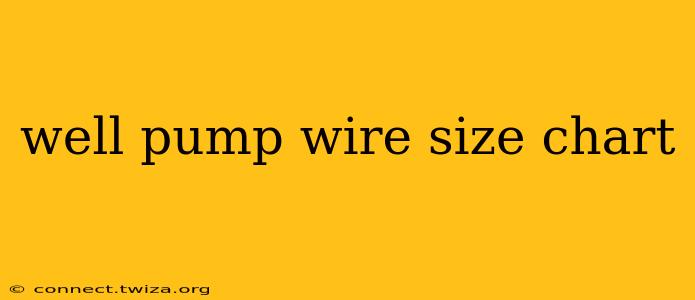Choosing the correct wire size for your well pump is crucial for safety, efficiency, and longevity. An undersized wire can overheat, leading to potential fire hazards and pump failure, while an oversized wire is unnecessary expense. This comprehensive guide will walk you through selecting the appropriate wire gauge based on your well pump's amperage draw and the distance to the power source. We'll also address common questions surrounding well pump wiring.
Understanding Amperage and Wire Gauge
The most important factors in determining the proper wire size are the well pump's amperage (amps) and the distance from the pump to the power source. Higher amperage requires thicker wire (lower gauge number) to safely carry the electrical current. Longer distances necessitate thicker wire to compensate for voltage drop.
Think of it like a water pipe: a larger pipe (thicker wire) can handle more water flow (higher amperage) with less pressure loss (voltage drop) over a longer distance.
Amperage: This is specified on the well pump's nameplate or motor data. It represents the amount of electrical current the pump draws during operation. Never guess; always check the pump's specifications!
Wire Gauge: This is a numerical representation of the wire's diameter. Lower gauge numbers indicate thicker wires, capable of carrying more current. For example, 10-gauge wire is thicker and can handle more amperage than 12-gauge wire.
How to Use a Well Pump Wire Size Chart (Example)
While a precise chart requires considering specific voltage and temperature conditions, a general guideline can be helpful. Remember, this is a simplification and should be considered a starting point:
| Amperage (Amps) | Wire Gauge (Minimum) | Distance (Approximate Maximum) | Notes |
|---|---|---|---|
| 5-7 Amps | 14 AWG | 100 feet | Suitable for smaller pumps |
| 8-10 Amps | 12 AWG | 150 feet | Commonly used for residential applications |
| 11-15 Amps | 10 AWG | 200 feet | For larger, higher-horsepower pumps |
| 16-20 Amps | 8 AWG | 250 feet | Requires careful consideration of voltage drop |
| 21+ Amps | 6 AWG or larger | Consult an electrician | Professional installation strongly recommended |
Important Note: This is a simplified chart. Actual wire size requirements may vary based on factors like ambient temperature, conduit type, and voltage drop calculations. Always consult the National Electrical Code (NEC) and local electrical codes for specific requirements.
What is voltage drop and why is it important?
Voltage drop refers to the reduction in voltage as electricity travels through a wire. A significant voltage drop can cause the pump to run inefficiently, overheat, or even fail to operate correctly. Longer distances increase voltage drop, necessitating thicker wire to minimize this effect.
Accurate voltage drop calculations require specialized formulas and often involve consulting an electrical engineer or experienced electrician.
What type of wire should I use for my well pump?
For well pump wiring, THHN (Thermoplastic High Heat-Resistant Nylon) or THWN (Thermoplastic High Heat-Resistant Nylon with a Moisture-Resistant outer coating) wires are commonly used. These types are designed to withstand the harsh conditions underground and provide excellent protection against moisture and heat. Always use wire rated for the appropriate temperature and voltage.
How much wire do I need for my well pump?
Calculate the total length of wire needed by doubling the distance from the power source to the well pump. You need wire for both the "hot" and "neutral" conductors, and potentially a ground wire.
Can I use extension cords for my well pump?
No. Extension cords are not designed for the sustained high amperage draw of a well pump and may overheat, posing a significant fire risk. Always use appropriately sized and rated wire specifically intended for permanent well pump installations.
Frequently Asked Questions (FAQ): Addressing PAA queries (note: PAA queries vary by search and location, these are examples)
What gauge wire is needed for a 10-amp well pump? A 12 AWG wire is generally sufficient for a 10-amp well pump, but consider the distance to the power source. Longer distances might require a thicker gauge.
What size wire is needed for a 2-horsepower well pump? The wire gauge depends on the amperage draw of the 2-horsepower pump, which is specified on the pump's nameplate. Consult the guidelines above and perform voltage drop calculations for an accurate determination. It's crucial to check the pump's specifications for this.
How to calculate wire size for a well pump? This involves calculating the amperage draw, distance to the power source, voltage drop, and applying the appropriate NEC and local code standards. Consulting an electrician is highly recommended. Using online calculators for voltage drop is also a good option.
Disclaimer: This information is for general guidance only. Always consult with a qualified electrician for proper sizing and installation of your well pump wiring to ensure safety and compliance with all relevant codes and regulations. Incorrect wiring can result in electrical hazards and equipment damage.
